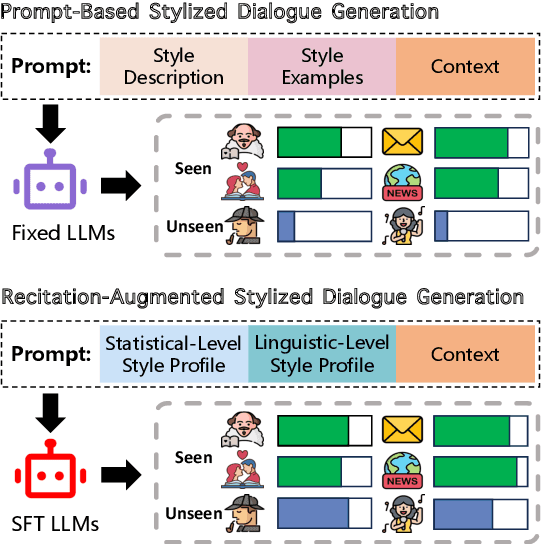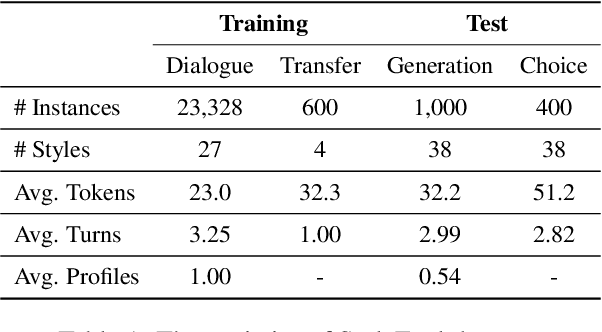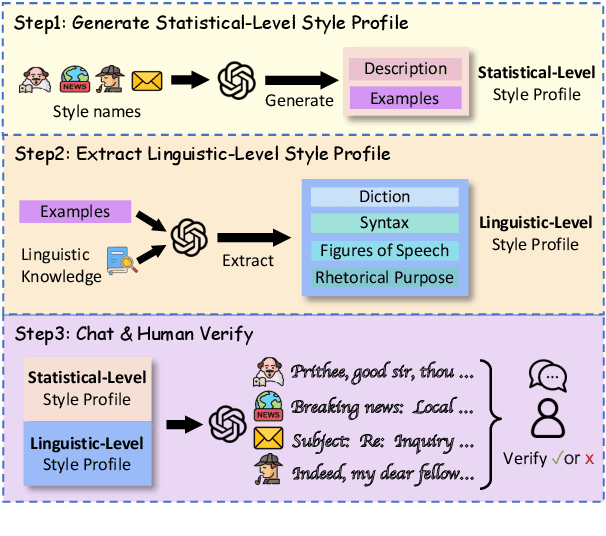Zekai Zhang
ActiveVLN: Towards Active Exploration via Multi-Turn RL in Vision-and-Language Navigation
Sep 16, 2025Abstract:The Vision-and-Language Navigation (VLN) task requires an agent to follow natural language instructions and navigate through complex environments. Existing MLLM-based VLN methods primarily rely on imitation learning (IL) and often use DAgger for post-training to mitigate covariate shift. While effective, these approaches incur substantial data collection and training costs. Reinforcement learning (RL) offers a promising alternative. However, prior VLN RL methods lack dynamic interaction with the environment and depend on expert trajectories for reward shaping, rather than engaging in open-ended active exploration. This restricts the agent's ability to discover diverse and plausible navigation routes. To address these limitations, we propose ActiveVLN, a VLN framework that explicitly enables active exploration through multi-turn RL. In the first stage, a small fraction of expert trajectories is used for IL to bootstrap the agent. In the second stage, the agent iteratively predicts and executes actions, automatically collects diverse trajectories, and optimizes multiple rollouts via the GRPO objective. To further improve RL efficiency, we introduce a dynamic early-stopping strategy to prune long-tail or likely failed trajectories, along with additional engineering optimizations. Experiments show that ActiveVLN achieves the largest performance gains over IL baselines compared to both DAgger-based and prior RL-based post-training methods, while reaching competitive performance with state-of-the-art approaches despite using a smaller model. Code and data will be released soon.
Understanding Generalization in Diffusion Models via Probability Flow Distance
May 26, 2025Abstract:Diffusion models have emerged as a powerful class of generative models, capable of producing high-quality samples that generalize beyond the training data. However, evaluating this generalization remains challenging: theoretical metrics are often impractical for high-dimensional data, while no practical metrics rigorously measure generalization. In this work, we bridge this gap by introducing probability flow distance ($\texttt{PFD}$), a theoretically grounded and computationally efficient metric to measure distributional generalization. Specifically, $\texttt{PFD}$ quantifies the distance between distributions by comparing their noise-to-data mappings induced by the probability flow ODE. Moreover, by using $\texttt{PFD}$ under a teacher-student evaluation protocol, we empirically uncover several key generalization behaviors in diffusion models, including: (1) scaling behavior from memorization to generalization, (2) early learning and double descent training dynamics, and (3) bias-variance decomposition. Beyond these insights, our work lays a foundation for future empirical and theoretical studies on generalization in diffusion models.
BACE-RUL: A Bi-directional Adversarial Network with Covariate Encoding for Machine Remaining Useful Life Prediction
Mar 14, 2025Abstract:Prognostic and Health Management (PHM) are crucial ways to avoid unnecessary maintenance for Cyber-Physical Systems (CPS) and improve system reliability. Predicting the Remaining Useful Life (RUL) is one of the most challenging tasks for PHM. Existing methods require prior knowledge about the system, contrived assumptions, or temporal mining to model the life cycles of machine equipment/devices, resulting in diminished accuracy and limited applicability in real-world scenarios. This paper proposes a Bi-directional Adversarial network with Covariate Encoding for machine Remaining Useful Life (BACE-RUL) prediction, which only adopts sensor measurements from the current life cycle to predict RUL rather than relying on previous consecutive cycle recordings. The current sensor measurements of mechanical devices are encoded to a conditional space to better understand the implicit inner mechanical status. The predictor is trained as a conditional generative network with the encoded sensor measurements as its conditions. Various experiments on several real-world datasets, including the turbofan aircraft engine dataset and the dataset collected from degradation experiments of Li-Ion battery cells, show that the proposed model is a general framework and outperforms state-of-the-art methods.
Understanding Representation Dynamics of Diffusion Models via Low-Dimensional Modeling
Feb 09, 2025



Abstract:This work addresses the critical question of why and when diffusion models, despite being designed for generative tasks, can excel at learning high-quality representations in a self-supervised manner. To address this, we develop a mathematical framework based on a low-dimensional data model and posterior estimation, revealing a fundamental trade-off between generation and representation quality near the final stage of image generation. Our analysis explains the unimodal representation dynamics across noise scales, mainly driven by the interplay between data denoising and class specification. Building on these insights, we propose an ensemble method that aggregates features across noise levels, significantly improving both clean performance and robustness under label noise. Extensive experiments on both synthetic and real-world datasets validate our findings.
Diffusion Models Learn Low-Dimensional Distributions via Subspace Clustering
Sep 04, 2024



Abstract:Recent empirical studies have demonstrated that diffusion models can effectively learn the image distribution and generate new samples. Remarkably, these models can achieve this even with a small number of training samples despite a large image dimension, circumventing the curse of dimensionality. In this work, we provide theoretical insights into this phenomenon by leveraging key empirical observations: (i) the low intrinsic dimensionality of image data, (ii) a union of manifold structure of image data, and (iii) the low-rank property of the denoising autoencoder in trained diffusion models. These observations motivate us to assume the underlying data distribution of image data as a mixture of low-rank Gaussians and to parameterize the denoising autoencoder as a low-rank model according to the score function of the assumed distribution. With these setups, we rigorously show that optimizing the training loss of diffusion models is equivalent to solving the canonical subspace clustering problem over the training samples. Based on this equivalence, we further show that the minimal number of samples required to learn the underlying distribution scales linearly with the intrinsic dimensions under the above data and model assumptions. This insight sheds light on why diffusion models can break the curse of dimensionality and exhibit the phase transition in learning distributions. Moreover, we empirically establish a correspondence between the subspaces and the semantic representations of image data, facilitating image editing. We validate these results with corroborated experimental results on both simulated distributions and image datasets.
RO-SVD: A Reconfigurable Hardware Copyright Protection Framework for AIGC Applications
Jun 17, 2024



Abstract:The dramatic surge in the utilisation of generative artificial intelligence (GenAI) underscores the need for a secure and efficient mechanism to responsibly manage, use and disseminate multi-dimensional data generated by artificial intelligence (AI). In this paper, we propose a blockchain-based copyright traceability framework called ring oscillator-singular value decomposition (RO-SVD), which introduces decomposition computing to approximate low-rank matrices generated from hardware entropy sources and establishes an AI-generated content (AIGC) copyright traceability mechanism at the device level. By leveraging the parallelism and reconfigurability of field-programmable gate arrays (FPGAs), our framework can be easily constructed on existing AI-accelerated devices and provide a low-cost solution to emerging copyright issues of AIGC. We developed a hardware-software (HW/SW) co-design prototype based on comprehensive analysis and on-board experiments with multiple AI-applicable FPGAs. Using AI-generated images as a case study, our framework demonstrated effectiveness and emphasised customisation, unpredictability, efficiency, management and reconfigurability. To the best of our knowledge, this is the first practical hardware study discussing and implementing copyright traceability specifically for AI-generated content.
E-Bench: Towards Evaluating the Ease-of-Use of Large Language Models
Jun 16, 2024Abstract:Most large language models (LLMs) are sensitive to prompts, and another synonymous expression or a typo may lead to unexpected results for the model. Composing an optimal prompt for a specific demand lacks theoretical support and relies entirely on human experimentation, which poses a considerable obstacle to popularizing generative artificial intelligence. However, there is no systematic analysis of the stability of LLMs in resisting prompt perturbations in real-world scenarios. In this work, we propose to evaluate the ease-of-use of LLMs and construct E-Bench, simulating the actual situation of human use from synonymous perturbation (including paraphrasing, simplification, and colloquialism) and typographical perturbation (such as typing). On this basis, we also discuss the combination of these two types of perturbation and analyze the main reasons for performance degradation. Experimental results indicate that with the increase of model size, although the ease-of-use are significantly improved, there is still a long way to go to build a sufficiently user-friendly model.
StyleChat: Learning Recitation-Augmented Memory in LLMs for Stylized Dialogue Generation
Mar 18, 2024



Abstract:Large Language Models (LLMs) demonstrate superior performance in generative scenarios and have attracted widespread attention. Among them, stylized dialogue generation is essential in the context of LLMs for building intelligent and engaging dialogue agent. However the ability of LLMs is data-driven and limited by data bias, leading to poor performance on specific tasks. In particular, stylized dialogue generation suffers from a severe lack of supervised data. Furthermore, although many prompt-based methods have been proposed to accomplish specific tasks, their performance in complex real-world scenarios involving a wide variety of dialog styles further enhancement. In this work, we first introduce a stylized dialogue dataset StyleEval with 38 styles by leveraging the generative power of LLMs comprehensively, which has been carefully constructed with rigorous human-led quality control. Based on this, we propose the stylized dialogue framework StyleChat via recitation-augmented memory strategy and multi-task style learning strategy to promote generalization ability. To evaluate the effectiveness of our approach, we created a test benchmark that included both a generation task and a choice task to comprehensively evaluate trained models and assess whether styles and preferences are remembered and understood. Experimental results show that our proposed framework StyleChat outperforms all the baselines and helps to break the style boundary of LLMs.
PPTC-R benchmark: Towards Evaluating the Robustness of Large Language Models for PowerPoint Task Completion
Mar 06, 2024



Abstract:The growing dependence on Large Language Models (LLMs) for finishing user instructions necessitates a comprehensive understanding of their robustness to complex task completion in real-world situations. To address this critical need, we propose the PowerPoint Task Completion Robustness benchmark (PPTC-R) to measure LLMs' robustness to the user PPT task instruction and software version. Specifically, we construct adversarial user instructions by attacking user instructions at sentence, semantic, and multi-language levels. To assess the robustness of Language Models to software versions, we vary the number of provided APIs to simulate both the newest version and earlier version settings. Subsequently, we test 3 closed-source and 4 open-source LLMs using a benchmark that incorporates these robustness settings, aiming to evaluate how deviations impact LLMs' API calls for task completion. We find that GPT-4 exhibits the highest performance and strong robustness in our benchmark, particularly in the version update and the multilingual settings. However, we find that all LLMs lose their robustness when confronted with multiple challenges (e.g., multi-turn) simultaneously, leading to significant performance drops. We further analyze the robustness behavior and error reasons of LLMs in our benchmark, which provide valuable insights for researchers to understand the LLM's robustness in task completion and develop more robust LLMs and agents. We release the code and data at \url{https://github.com/ZekaiGalaxy/PPTCR}.
StrokeNUWA: Tokenizing Strokes for Vector Graphic Synthesis
Jan 30, 2024Abstract:To leverage LLMs for visual synthesis, traditional methods convert raster image information into discrete grid tokens through specialized visual modules, while disrupting the model's ability to capture the true semantic representation of visual scenes. This paper posits that an alternative representation of images, vector graphics, can effectively surmount this limitation by enabling a more natural and semantically coherent segmentation of the image information. Thus, we introduce StrokeNUWA, a pioneering work exploring a better visual representation ''stroke tokens'' on vector graphics, which is inherently visual semantics rich, naturally compatible with LLMs, and highly compressed. Equipped with stroke tokens, StrokeNUWA can significantly surpass traditional LLM-based and optimization-based methods across various metrics in the vector graphic generation task. Besides, StrokeNUWA achieves up to a 94x speedup in inference over the speed of prior methods with an exceptional SVG code compression ratio of 6.9%.
 Add to Chrome
Add to Chrome Add to Firefox
Add to Firefox Add to Edge
Add to Edge